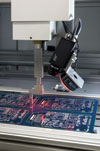Automatic labelling is fast and efficient
February 2012
Sensors & Transducers

Brady’s patented range of hardware and consumables overcomes the challenges of automatic label application and is now available in South Africa. Auto-Apply simplifies wire, cable and component marking, including circuit boards, and provides complete automatic labelling and identification that improves productivity by combining the print and apply process into one unit.
The label applicator provides accurate real-time labelling and the in-line verification removes errors. Brady has developed a range of labels specifically for this automatic process that has the advantages of no cutting into the liner, no adhesive bleeding and no label curling. The labels are also able to withstand high temperatures and chemicals to maintain data integrity, correct adhesives ensure permanent sticking even in the harshest environments.
Apart from the obvious benefits of speed and efficiency, the system also ensures 100% traceability with batch and in-line identification, particularly useful for companies who prefer to label components in batches prior to main assembly. Once labelled, the components can be taken to the main production process for full assembly. The system also allows for easy tracking of defective parts, improves manufacturing cycles, streamlines inspection processes and provides consistent quality assurance.
For more information contact Darryl Crampton, Grafo Wiremakers Africa, +27 (0)11 704 3295, [email protected], www.grafo.co.za
Further reading:
Adjustable proximity sensor with five metre range
Sensors & Transducers
The Telco line of photo-electric eyes have the accuracy and reliability you need.
Read more...
Food safety – a matter of weight
Sensors & Transducers
Weighing systems play a key role in ensuring product quality in food production, complying with legal requirements and avoiding product recalls. The Minebea Intec MiNexx portfolio has been specially developed to meet these requirements.
Read more...
Telco sensors in the paper and pulp industry
Sensors & Transducers
The paper and pulp industry poses a major problem for most photoelectric sensors. Telco Sensors has overcome this with its powerful and high-performance photoelectric sensors, ensuring penetration of thick and harsh pollution while guaranteeing reliable detection.
Read more...
Leaders in sensor technology
Sensors & Transducers
A new addition to the Telco Sensors range is the adjustable Proximity sensor, with a range up to 5 metres.
Read more...
Cutting-edge sensor technology
Endress+Hauser South Africa
Sensors & Transducers
The advantage of Endress+Hauser’s Memosens technology is that digitised measured values and sensor information are transmitted via a non-contact connection from the sensor to the cable, and as a digital signal to the transmitter.
Read more...
Miniature inductive sensors
ifm - South Africa
Sensors & Transducers
The inductive IY/IZ type sensors from ifm are used in various industrial areas where space is limited.
Read more...
The expanding role of 3D cameras in industrial quality control
TANDM Technologies
Sensors & Transducers
Across factory floors, warehouses, mines and research centres worldwide, computer vision paired with 3D camera technology is revolutionising quality control.
Read more...
PDS implementation on mines
Sensors & Transducers
Level 9 vehicle intervention for collision avoidance has been mandatory on South African mines since 2022, yet the effective roll-out of proximity detection systems remains slower than expected. This is not due to the technical limitations of integration but to operational readiness on site.
Read more...
Monitoring analogue process values
ifm - South Africa
Sensors & Transducers
Everywhere in industry, electronic sensors are used to detect process values such as temperature, pressure or flow. Process value monitoring often takes place directly in the sensor.
Read more...
Protecting buildings’ embodied carbon with retrofitted systems
Schneider Electric South Africa
Sensors & Transducers
The World Economic Forum has said that around 80% of the buildings in existence will still be around in 2050; it is therefore essential that in order to combat climate change we retrofit them for energy efficiency.
Read more...


